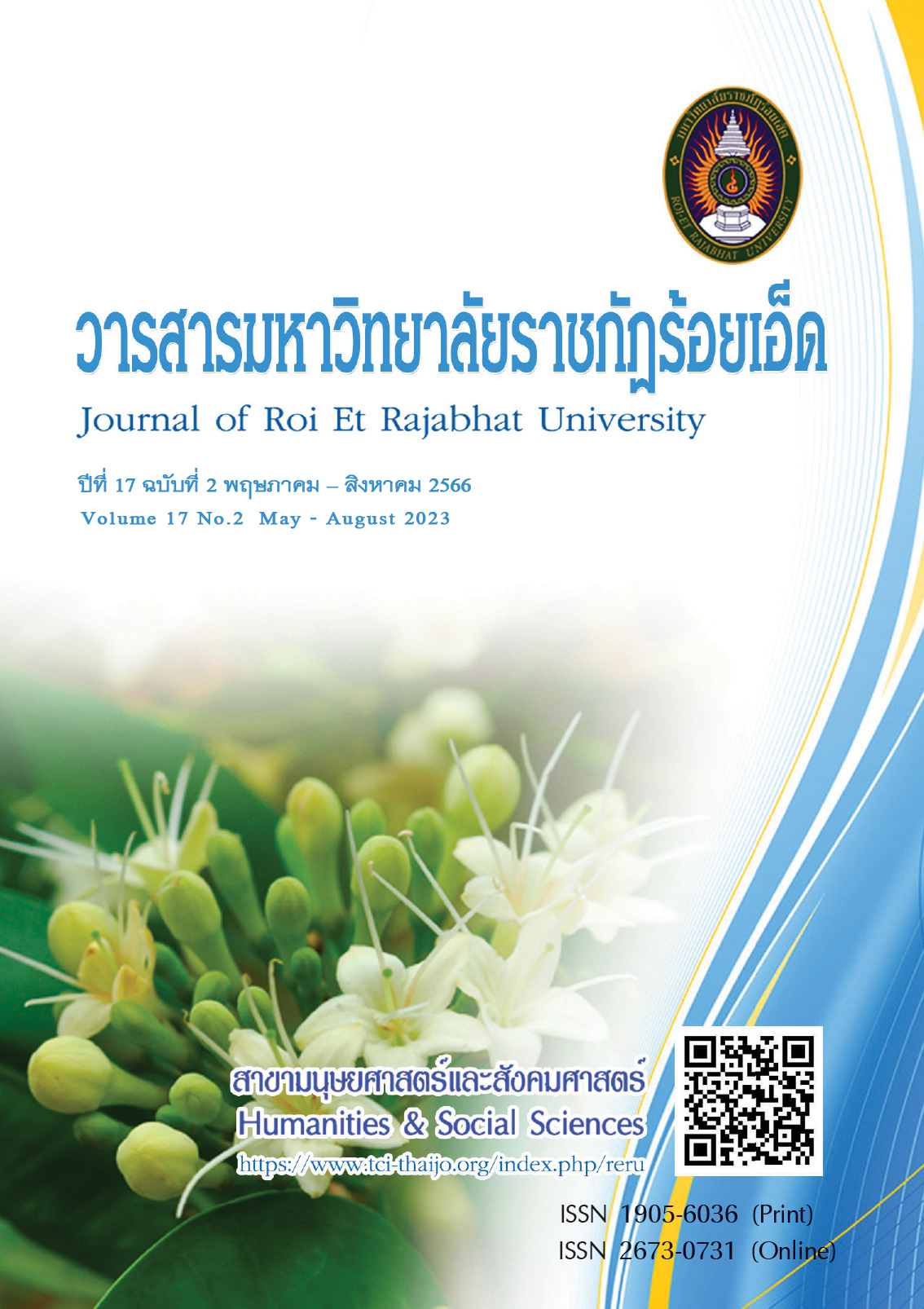Factors Related to Organic Agriculture Brand Equity and Purchase Intention of Organic Agriculture Product via Online Market: A Case of Consumers in Udonthani
Keywords:
Brand equity, Organic agriculture brand, Purchase intentionAbstract
The purposes of this research were (1) to compare the opinions of the organic brand equity of consumers with different demographic characteristics (2) to study the relation of marketing mix of organic agricultural product and organic brand equity (3) to study the influence of marketing mix of organic agricultural product on purchase intention of organic agriculture products in online market. This quantitative research collected the data by using questionnaires from 390 samples. The statistics used to analyze the data were percentage, mean, and standard deviation, testing of hypothesis by Independent Sample t-test, One Way ANOVA and multiple regression analysis.
The results showed that the different demographic factors including age, education level, occupation and average monthly income influence to the brand equity of organic agriculture products differently.
The marketing mix of organic agriculture products (4Ps) had a positive relation to organic brand equity. And the brand equity of organic agriculture products affected the purchase intention of organic agriculture products in online market. And the testing of each aspect found that organic brand equity in aspect of perceived quality, brand association and brand loyalty had a positive influence to purchase intention of organic agriculture products which brand equity in aspect of brand loyalty had the highest influence, followed by perceived quality and brand association.
References
คณิต สุขรัตน์ และ ดุสิต อธินุวัฒน์. (2562). การศึกษาพฤติกรรมการบริโภคและทัศนคติของผู้บริโภคสินค้าอินทรีย์. Thai Journal of Science and Technology (TJST), 9(1), 68 – 76.
คณะกรรมการพัฒนาเกษตรอินทรีย์แห่งชาติ. (2564). รายงานผลการขับเคลื่อนยุทธศาสตร์การพัฒนาเกษตรอินทรีย์แห่งชาติพ.ศ.2560-2564. สืบค้นเมื่อวันที่ 22 ธันวาคม 2564, จาก https://www.oae.go.th/view/139207/TH-TH.
ชนิตา พันธุ์มณี และ รภัสรณ์ คงธนจารุอนันต์. (2555). ความยินดีที่จะจ่ายและความสามารถที่จะจ่ายได้สำหรับผักสดอินทรีย์ของผู้บริโภคในจังหวัดเชียงใหม่. รายงานผลวิจัย คณะเศรษฐศาสตร์ มหาวิทยาลัยแม่โจ้.
ธานินทร์ ศิลป์จารุ. (2557). การวิจัยและวิเคราะห์ข้อมูลทางสถิติด้วย SPSS และ AMOS (พิมพ์ครั้งที่ 15): นนทบุรี: เอส.อาร์.พริ้นติ้ง แมสโปรดักส์.
นภวรรณ คณานุรักษ์. (2561). คุณค่าตราสินค้าที่ส่งผลต่อความตั้งใจซื้อตราสินค้ารองเท้ากีฬาของผู้บริโภคในเขตกรุงเทพมหานคร. วารสารการจัดการสมัยใหม่, 16(1), 207-218.
ปิยวรรณ สิริประเสริฐศิลป์, อนุชา กันทรดุษฎี, กัญญ์พัสวี กล่อมธงเจริญ และ โสภณ ฟองเพชร. (2562). การบริโภคสินค้า
และอาหารอินทรีย์ของประชาชนในเขตอำเภอสันทราย จังหวัดเชียงใหม่. วารสารบัณฑิตศึกษา มหาวิทยาลัย
ราชภัฏเชียงราย, 12(2), 105-117.
พัชร พิลึก, เชาว์ โรจนแสง และ วุฒิชาติ สุนทรสมัย. (2564). การพัฒนารูปแบบกลยุทธ์คุณค่าตราสินค้าข้าวอินทรีย์ไทย.
วารสารสังคมศาสตร์และมานุษยวิทยาเชิงพุทธ, 6(9), 1-18.
สืบชาติ อันทะไชย. (2565). อิทธิพลของการตระหนักรู้ตรา ต่อภาพลักษณ์และคุณค่าตรา การส่งผ่านเชิงการกำกับของการรับรู้คุณภาพ: กรณีศึกษาของตลาดผ้านาข่า จังหวัดอุดรธานี. วารสารบริหารธุรกิจนิด้า, 30(1), 9 – 27.
สำนักงานเศรษฐกิจการเกษตร. (2565). ส่งออกสินค้าเกษตรอินทรีย์ไทย ยังฉลุย มูลค่าการส่งออกขยายตัว 44.46 % ต่อปี.
สืบค้นเมื่อ 25 มิถุนายน 2565, จาก https://www.oae.go.th/view/181./38177/TH-TH.
สำนักงานเศรษฐกิจการเกษตรที่ 3 อุดรธานี. (2565). ขับเคลื่อนมาตรฐานการผลิตอาหารอินทรีย์ของกลุ่มเกษตรกร
จังหวัดอุดรธานี. สืบค้นเมื่อ 25 มิถุนายน 2565, จาก https://thainews.prd.go.th/th/news/print_news/TCATG200805144609189
Aaker, D. A. (2014). Aaker on Branding: 20 Principles that Drive Success. New York: Morgan James Publishing.
Athapaththu, J. C. and Kulathunga, K. M. S. D. (2018). Factors affecting online purchase intention: A study of Sri Lankan online customers. Journal of Scientific & Technology Research, 7(9), 119-128.
Australian Organic. (2021). The Australian organic market report 2021. Retrieved October 8, 2021, from https://austorganic.com/industry/publications/market-report-2021/.
Buil, I. and Martinez, E. (2013). The influence of brand equity on consumer responses. Journal of Consumer Marketing, 30(1), 62-74.
Castaldo S., Perrini F, Misani N. and Tencati A. (2009). The missing link between corporate social responsibility and consumer trust: the case of fair-trade products. Journal of Business Ethics 84(1), 1–15.
Chattopadhyay T., S. Shivani and M. Krishnan. (2010). Marketing Mix Elements Influencing Brand Equity and Brand Choice. Retrieved October 8, 2021, from https://www.researchgate.net/publication/289675536_Marketing_Mix_Elements_ Influencing_
Brand_Equity_and_Brand_Choice
Chen, C., Chen, P. and Huang, C. (2012). Enhance green purchase intentions: The roles of green perceived value, green perceived risk, and green trust. Management Decision, 50(3), 502-520.
Chen, Y. and Chang, C. (2013). Towards green trust: the influences of green perceived quality,
green perceived risk, and green satisfaction. Management Decision, 51(1), 63-82.
Cochran, W.G. (1997). Sampling techniques (3rd ed.). New York: John Wiley & sons.
Gracia, A. and Magistris, T. (2007). Organic food product purchase behavior: a pilot study for urban consumers in the South of Italy. Spanish Journal of Agricultural Research, 5(4), 439-451.
Hair, J.F., Black, W.C., Babin, B.J. and Anderson, R.E. (2010). Multivariate Data Analysis (7th ed). New Jersey: Pearson Education.
Hawkins, K. and Vel, P. (2013). Attitudinal loyalty, behavioral loyalty and social media: An Introspection. The Marketing Review, 13(2), 125-141.
Jalil, M. A. and Shaharudin, M. R. (2010). Consumer's perception and purchase intention toward organic food products: Exploring attitude among academician. Canadian Social Science, 6(6), 119–129.
Keller, K. L. (2012). Strategic Brand Management: Building, Measuring, and Managing Brand Equity (4th ed.), Prentice Hall.
Kang, S. and Hur, W.M. (2012). Investigating the Antecedents of Green Brand Equity: A Sustainable Development Perspective. Corporate Social Responsibility and Environmental Management, 19(2011), 306-316.
Liu, Rongduo, Pieniak, Zuzanna and Verbeke, Wim. (2014). Food-related hazards in China: Consumers' perceptions of risk and trust in information sources. Food Control, 46(1), 291-298.
Mukherjee, S. and Shivani, S. (2016). Marketing mix influence on service brand equity and its dimensions.
Retrieved June 25, 2021, from DOI: 10.1177/0972262916628936
Udonthani Update. (2565). Facebook page: Udonthani Update. Retrieved March 20, 2022,
from https://m.facebook.com/196552780439832.
Zikmund, W.G., Babin, B. J., Carr, J. C. and Griffin, M. (2010). Business research methods (8th ed.). Canada: South-Western, Cengage Learning.
Published
How to Cite
Issue
Section
License
Copyright (c) 2023 Roi Et Rajabhat University

This work is licensed under a Creative Commons Attribution-NonCommercial-NoDerivatives 4.0 International License.
บทความที่ได้รับการตีพิมพ์เป็นลิขสิทธิ์ของวารสารมหาวิทยาลัยราชภัฎร้อยเอ็ด
ข้อความที่ปรากฏในบทความแต่ละเรื่องในวารสารวิชาการเล่มนี้เป็นความคิดเห็นส่วนตัวของผู้เขียนแต่ละท่านไม่เกี่ยวข้องกับมหาวิทยาลัยราชภัฎร้อยเอ็ด และคณาจารย์ท่านอื่นๆในมหาวิทยาลัยฯ แต่อย่างใด ความรับผิดชอบองค์ประกอบทั้งหมดของบทความแต่ละเรื่องเป็นของผู้เขียนแต่ละท่าน หากมีความผิดพลาดใดๆ ผู้เขียนแต่ละท่านจะรับผิดชอบบทความของตนเองแต่ผู้เดียว





